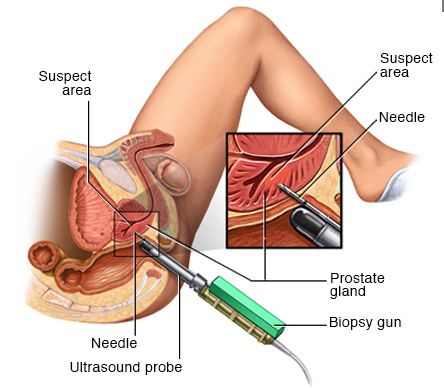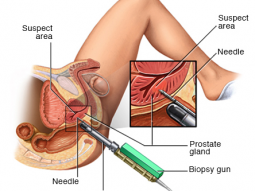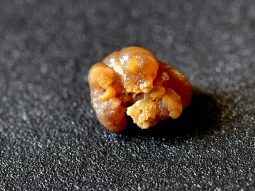WHAT IS PROSTATE BIOPSY?
The prostate is a small, walnut-shaped gland in men that produces fluid that nourishes and transports sperm. A prostate biopsy is a procedure to remove samples of suspicious tissue from the prostate. It is performed by an urologist, who is a doctor specialized in the urinary system and men’s sex organs.
WHY IT’S DONE
A prostate biopsy is the main method used to detect prostate cancer. Your doctor may recommend a prostate biopsy if:
- Results of a prostate-specific antigen (PSA) test are higher than normal for your age
- Your doctor found lumps or other abnormalities during a digital rectal exam.
- You’ve had a previous biopsy that’s normal, but you still have elevated PSA levels.
- A previous biopsy revealed prostate tissue cells that were abnormal but not cancerous.

To prepare you for your prostate biopsy, your urologist may have you:
- Stop taking medication that can affect blood clotting such as aspirin, warfarin (Coumadin®), non-steroidal anti-inflammatory medications (NSAIDs) such as ibuprofen, and certain herbal supplements five to seven days before the procedure.
- Do a cleansing enema at home before your biopsy appointment. This will help prevent the biopsy area from infection due to contamination with faeces.
- Take antibiotics, following your doctor prescription, 30 to 60 minutes before your prostate biopsy to help prevent infection.
WHAT YOU CAN EXPECT
A prostate biopsy is usually performed on Day ward. Procedures may vary depending on your condition and your doctor practices.
During a prostate biopsy, a fine needle is used to collect a number of tissue samples from your prostate gland. Generally, doctors collect prostate biopsy samples through the wall of the rectum. This is called a trans-rectal prostate biopsy. Less often, the prostate is accessed through the tip of the penis (urethra), or through the space between the anus and scrotum (perineum).
For a trans-rectal prostate biopsy, your doctor will start by having you lie on your side, with your knees pulled up to your chest.
After cleaning the biopsy area and applying numbing gel, your doctor will gently insert a thin ultrasound probe into your rectum. Trans-rectal ultrasonography is used to create images of your prostate using sound waves. Your doctor will use the image to identify the area that needs to be numbed with an anesthetic injection, if one is used. It’s also used to guide the prostate biopsy device into place.
Once the biopsy device is into the right place in the prostate, your doctor will retrieve thin, cylindrical sections of tissue with a hollow, spring-propelled needle. The procedure typically causes a very brief, uncomfortable sensation each time the fine needle takes a sample. Your doctor may target a suspicious area to biopsy, or may take samples from several places in your prostate. In most cases, doctor will take 10 to 12 tissue samples or more if necessary. The entire procedure usually takes about 20 to 30 minutes.
Tissue samples from the prostate biopsy are sent to a specialized pathology laboratory and examined under a microscope for cell abnormalities that are a sign of prostate cancer. If cancer is present, it is evaluated to determine how quickly it is likely to grow and spread and to determine your best treatment options.
RISKS:
Common risks associated with a prostate biopsy include:
- Infection. The most common risk associated with a prostate biopsy is infection. Rarely, men who have a prostate biopsy develop an infection of the urinary tract or prostate that requires treatment with antibiotics.
- Bleeding at the biopsy site. Bleeding is common after a prostate biopsy. Don’t start taking any blood-thinning medications after your biopsy until your doctor says it’s OK.
- Blood in your semen. Up to half the men who have a prostate biopsy report blood in their semen after the procedure. This is not a cause for concern and may persist for four to six weeks after biopsy.
- Urinary retention. In some men prostate biopsy can cause difficulty passing urine after the procedure. Rarely, a temporary urinary catheter needs to be inserted.
AFTER THE PROCEDURE
After a prostate biopsy, you’ll probably need to continue taking an antibiotic for a few days. You may feel slight soreness and have some light bleeding from your rectum. You may have blood in your urine or stools for a few days. You may also notice that your semen has a pinkish tint caused by a small amount of blood in your semen. This can last for more than a month.
Call your doctor or come to the hospital if you have:
- Prolonged or heavy bleeding
- Pain that gets worse
- Swelling near the biopsy area
- Difficulty urinating
In rare cases, a prostate biopsy can lead to infection. If you have any signs of infection, call your doctor or come to the hospital. Signs and symptoms of infection include:
- Fever
- Pain when urinating
- Discharge from your penis.
RESULT
A pathologist will evaluate the prostate biopsy samples. The pathologist can tell if the tissue removed is cancerous and, if cancer is present, estimate how aggressive it is. The pathologist compiles the laboratory findings in a pathology report that’s given to your doctor. Your doctor will explain the findings to you
For further enquiries and appointment, please contact the Urology Department – FV Hospital at: (028) 54 11 34 33 – ext : 1250. And in case of Emergency: (028) 54 11 35 00
This information is for education purposes and is not intended to replace a consultation with specialist doctor. If you have questions concerning your care, please discuss them with your doctor

 Vi
Vi 












